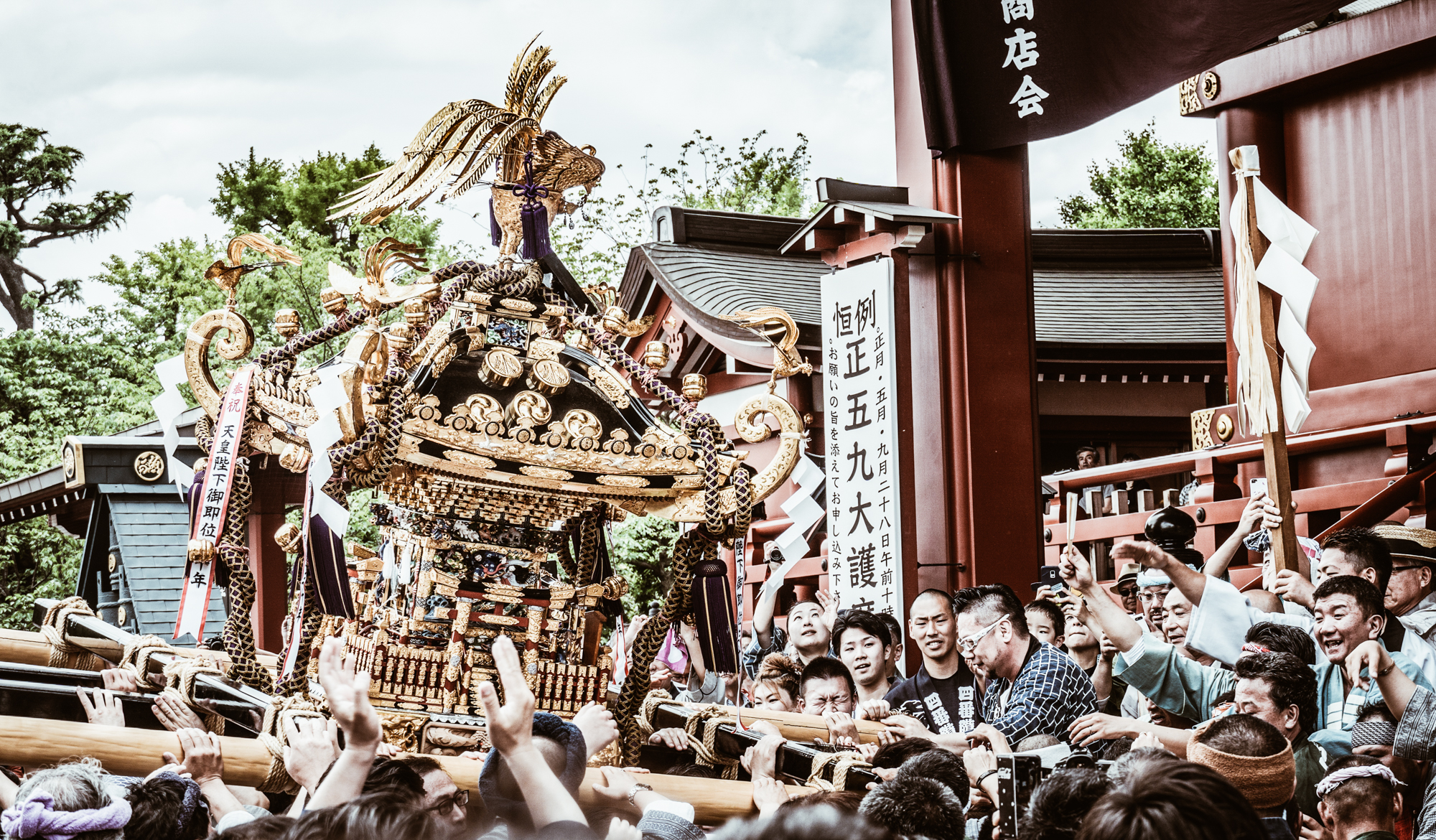Japan Tradition: Sanja Matsuri
photo credits: Yoshikazu TAKADA
The festival of the three temples
The Sanja Matsuri (三社祭) is one of the most famous festivals, largest and “wildest” festivals in Tokyo dedicated to the Shinto religion. The festival is held in honor of Hinokuma Hamanari, Hinokuma Takenari and Hajino Nakatomo, the three men who founded the Sensō-ji temple.
The Sanja Matsuri is held on the third weekend of May at the Asakusa temple and the sumptuous parade involves three mikoshi (portable temples), dances, traditional music and lasts about three days.
Like most Japanese festivals, the Sanja matsuri is also a religious celebration dedicated to the spirits of the three men, founders of the temple. This festival seems to have been born in the 7th century and is also known as “Kannon Matsuri” and “Asakusa Matsuri” and with a different shape than today.
The modalities in which today’s Sanja Matsuri is organized were established during the Edo period when in 1649 the shogun Tokugawa Iemitsu commissioned the construction of the Asakusa temple.
If you happen to be around Asakusa during the festival days, you can feel an atmosphere full of energy. People flock to the streets surrounding the Sensō-ji temple to the sound of flutes, whistles and taiko (traditional Japanese percussion).


photo credits: Atsushi Ebara, Yoshikazu TAKADA
The Mikoshi
The main attraction of this festival is the three mokoshi belonging to the Asakusa temple. These three elaborate temples in black lacquered wood have the function of being a miniature and a portable version of the Asakusa Temple. Decorated with sculptures and golden leaves, they weigh about a ton and are transported by long poles held together by ropes. For each mikoshi there is a need for about 40 people for safe transport and during the day, around 500 people participate in the transport of each temple.
The “parade” of these mikoshi is perhaps the most important moment of the day and the streets are crowded as they pass. As they are also transported, they are agitated and made to bounce strongly, because it is said that this leads to intensifying the power of the Kami inside and that it helps to increase luck in the respective neighborhoods.
While the three main mikoshi are the most important objects in the streets during the Sanja Matsuri, there are about 100 other smaller mikoshi scattered in the neighborhood on Saturday. Many of these temples are also transported by women or children.


Day after day
The Sanja matsuri, is a festival that lasts several days and begins on Thursday with an important religious ceremony. This function requires the priest responsible for the temple to perform a ritual that makes the Kami of the three founders of the temple move from within into the three mikoshi. The latter will then be the protagonists of the parade that will last all weekend in Asakusa.
By opening the three small doors of the mikoshi the three spirits are invited to enter the miniature temples where they will stay for the duration of the festival. The interior of these mikoshi is also concealed from the public by a thin cotton curtain.

photo credits: Yoshikazu TAKADA
But the actual parade begins on Friday, known as Daigyōretsu (大 行列) which literally means “great parade”.
The famous procession goes down via Yanagi Street and continues to the Nakamise-dōri up to the Asakusa temple. This festival is also well known for the sumptuous costumes of the participants, but also for the geishas and city officials who wear hakama, traditional Japanese clothes.
In the evening, six mikoshi from the most central neighborhoods are sent in procession on the shoulders of several dozen people.


photo credits: Hong Seongwan, Yoshikazu TAKADA
The following day, Saturday, about 100 mikoshi belonging to the 44 districts of Asakusa gather at the Kaminarimon and then leave on parade via the Nakamise-dōri in the direction of Hōzōmon. Once here they pay their respects to Kannon, the goddess of Mercy. Later, the mikoshi are taken to the Asakusa temple where the Shinto priest blesses them and purifies them for the coming year. Once the ceremony is completed, these small portable temples are transported back to their respective neighborhoods.
However, the most important event of the Sanja Matsuri takes place on Sunday. It is in this day in fact that we can see the parade of the three mikoshi belonging to the Asakusa Shrine. They march along the Nakamise-dōri to arrive at the Kaminarimon on Sunday morning. These three mikoshi enclose the three spirits of the three founding men of the Sensō-ji temple and, during the final day of this festival, they come to visit and bring blessings to the 44 districts of Asakusa.
When evening arrives, the three mikoshi find their way back to the Asakusa temple creating another great procession that lasts until late at night.


photo credits: ageless foto, Yoshikazu TAKADA
Yakuza Show
This festival of monumental size, also allows to mix fringes of the population that usually remain very detached. It is indeed common to find the Yakuza performing in fundoshi, without shame or fear, proudly showing their tattoos. In the eyes of a westerner, not accustomed to Japanese culture, this could almost seem like a comic scene. However, don’t dare to laugh if you don’t want bad luck to hit you!


photo credits: Hong Seongwan, syasya_akemi
Share this:
- Click to share on Facebook (Opens in new window)
- Click to share on Twitter (Opens in new window)
- Click to share on Tumblr (Opens in new window)
- Click to share on Pinterest (Opens in new window)
- Click to share on Telegram (Opens in new window)
- Click to share on WhatsApp (Opens in new window)
- Click to share on Reddit (Opens in new window)
- Click to print (Opens in new window)







